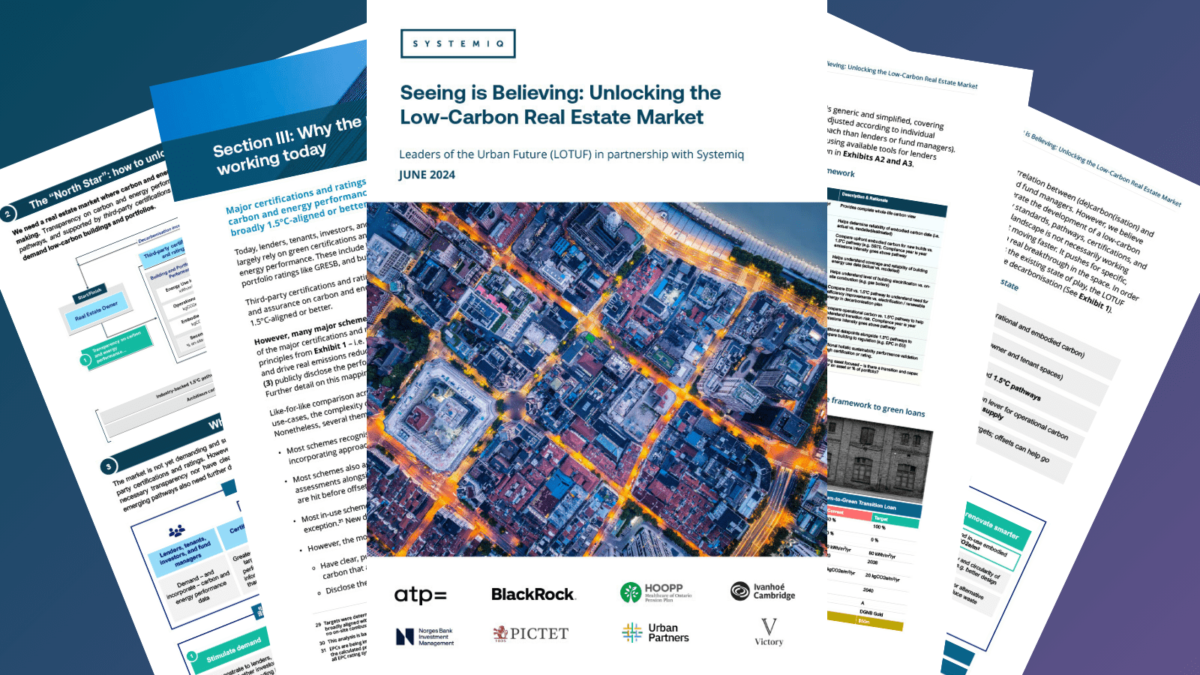
Making green buildings actually happen
Sometimes good data is the key that unlocks change. In this case the data that is needed is how well aligned buildings are with industry agreed 1.5C aligned pathways.
Sometimes good data is the key that unlocks change. In this case the data that is needed is how well aligned buildings are with industry agreed 1.5C aligned pathways. This could give investors confidence that the buildings really are greener. And potentially kick start a $600bn p.a. programme to decarbonise our existing building stock.
Sometimes not having data can be used as an excuse to kick the can down the road, but not in this case. We need better transparency if we are to drive change.
This is a What Caught Our Eye story - highlighting reports, research and commentary at the interface of finance and sustainability. Things we think you should be reading, and pointing out the less obvious implications. All from a finance perspective.
It's free to become a member ... just click on the link at the bottom of this blog or the subscribe button. Members get a summary of our weekly posts, including What Caught Our Eye and Sunday Brunch, delivered straight to your inbox. Never miss another blog post !
Seeing is Believing: Unlocking the Low-Carbon Real Estate Market - a report from Systemiq
We all know the importance of decarbonising our buildings. And just in case you don't already know, real estate produces nearly 40% of the world's energy related GHG emissions.
The good news is that we know how to make buildings greener. And the even better news is that green buildings are probably more valuable. Yes, we struggle to be certain how big the green premium is - this needs more work. But, according to a recent LaSalle meta study "the data supports a conclusion with high conviction that green characteristics are accretive to rents and values".
And as the recent study highlighted above by Systemiq for the Leaders of the Urban Future (LOTUF) project set out:
"Low-carbon (i.e. 1.5°C-aligned or better) buildings are fundamentally better buildings and they should have benefits for lenders, tenants, investors (LPs), and fund managers (GPs). These include:
(1) cost savings and revenue streams associated with more efficient, flexible, grid integrated buildings,
(2) asset de-risking against future carbon and energy regulation, and
(3) achievement of in-house climate commitments and financed emissions targets."

But this prompts the obvious question.
If green buildings are deliverable using existing proven technologies. And if they positively enhance rents and building value, plus they assist investors in achieving 'promised' net zero targets, why don't we have more of them?
Or asking the question slightly differently ....why is the green real estate market not working as well as it could?
Systemiq offer a simple answer. The current building certification and ratings tools do not provide transparency on carbon and energy performance and do not have clear targets that are broadly 1.5°C-aligned or better.
Let's take a step back. The institutional real estate investment market is large, at around $12tn globally. If you as an institutional investor want to own a greener building, you don't check out the building yourself. You rely on green certifications and ratings to 'proxy' a building or portfolio’s carbon and energy performance. These include holistic building certifications like LEED and BREEAM, portfolio ratings like GRESB, and building energy ratings like NABERS, EnergyStar, and EPCs.
As Systemiq sets out in their report, these schemes have pro's and con's. They are pretty good at looking at all building emissions (in some cases including some form of whole life evaluation). And most (but not all - the exception is EPC's) are performance-based, requiring actual energy use data.
But, most DO NOT have clear, publicly available targets for energy use, operational carbon, and embodied carbon that are broadly 1.5°C-aligned or better. And for many institutional investors this is important, they want their portfolios to be 1.5 C aligned.
So, the end result is that investors who are looking for low carbon buildings are struggling to identify the assets they want. Or putting this in investor speak "the ultimate outcome is limited confidence for real estate owners – whose mandates are to create and preserve value – to invest in deep decarbonisation across their assets and portfolios."
It's worth putting this in a financial context. Deep decarbonisation of buildings will require significant investment. Around $600bn p.a. globally from now to 2050, just to retrofit our existing stock. That feels like an investment opportunity with real potential.
It might seem odd that such a simple barrier can block increasingly levels of investment in green buildings. You would think it is easy for an investor to find a 'green' building. But it's not so odd if you think about real estate investing as a market - one that buys and sells buildings.
Well functioning financial markets need transparency.
If we think about markets for stocks and shares. If we buy through a recognised financial exchange, say Nasdaq, we know what it is we are buying. And we have accounting rules that set out how the companies should report their financial performance. We have transparency - it's not perfect, but it's good enough to allow $billions of shares to be traded every day.
We can apply a similar analogy to real estate. Lenders, tenants, investors and fund managers need transparency as to the carbon and energy performance of the buildings they want to trade. They need clear industry accepted targets that allow them to compare a buildings performance against a commonly agreed set of 1.5°C pathways. And they need these 'standards' to be applied through the industry, to be used by the certification and ratings agencies, and by the property valuers.
For this to happen we need everyone involved in the real estate industry to buy in.
Yes, this will be a slog, getting these processes in place. But then fixing an industry produces nearly 40% of the world's energy related GHG emissions feels like it's worth the effort. And it's not like the investment opportunity is trivial - remember $600bn p.a. globally !
We wrote about the value of green buildings back in September 2023, highlighting a series of studies that examined the green premium.


Please read: important legal stuff.




